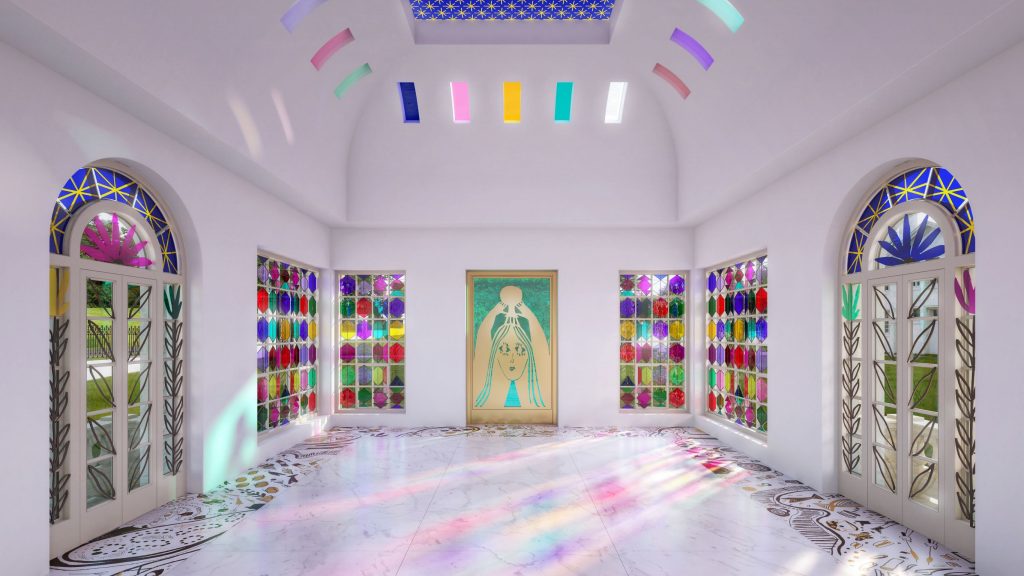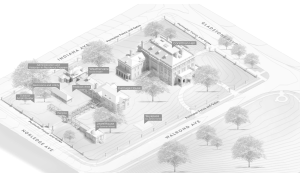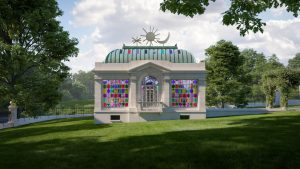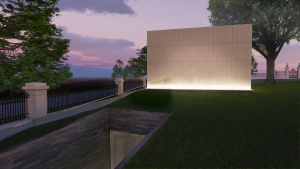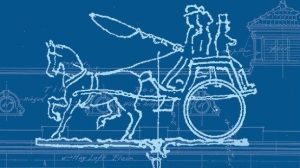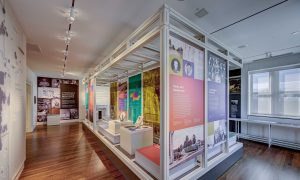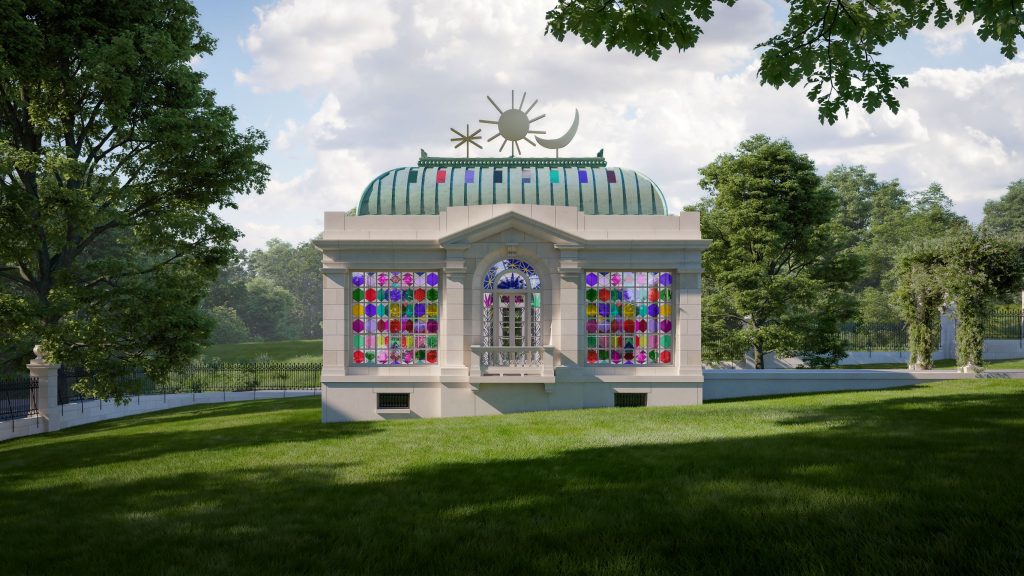
The Kansas City Museum is working with New York-based artist Summer Wheat and Kansas City-based International Architects Atelier (IAA) to design JewelHouse—a monumental, site-responsive contemporary artwork and groundbreaking architectural intervention that reimagines the Museum’s former Beaux-Arts conservatory. The project is in the final design phase of completing construction documents, and more information on a groundbreaking date is forthcoming. Fundraising is ongoing. To contribute, click here or contact Anna Marie Tutera at atutera@kansascitymuseum.org.
Built in 1910 to store plants in the winter and modified in the early 1950s to create a planetarium, the conservatory will be restored and renovated to its original architecture with new glass, bronze, and mosaic contemporary artworks by Summer Wheat integrated into the exterior and interior of the building. As part of a broad initiative to reinvigorate and renovate the Kansas City Museum’s grounds, Wheat will transform the conservatory into a jewel box of a space to be used by the public for meditative reflection in addition to hosting a robust slate of programming that promotes gender equity, empowerment, health, and well-being.
JewelHouse will be a light-filled, immersive, and inclusive sanctuary for contemplation, reflection, and renewal, as well as a hub for awareness, connection, inspiration, and action. Aligning with the Museum’s work in restorative practices, JewelHouse will provide solace or stimulus for those who seek engagement, reconciliation, and healing.
A priority goal for creating and sustaining JewelHouse is to inspire active matronage and women-led support and collaboration in all aspects and at all levels of the project. For JewelHouse, we define matronage as the leadership role women have always played in philanthropy and bold community-based endeavors to be the truth-tellers, knowledge-bearers, and guardians of the whole story. This lens is particularly meaningful in the context of the Kansas City Museum, which has benefitted from a long history of women’s support and leadership. JewelHouse will, in turn, inspire a proliferation of “matronage.”
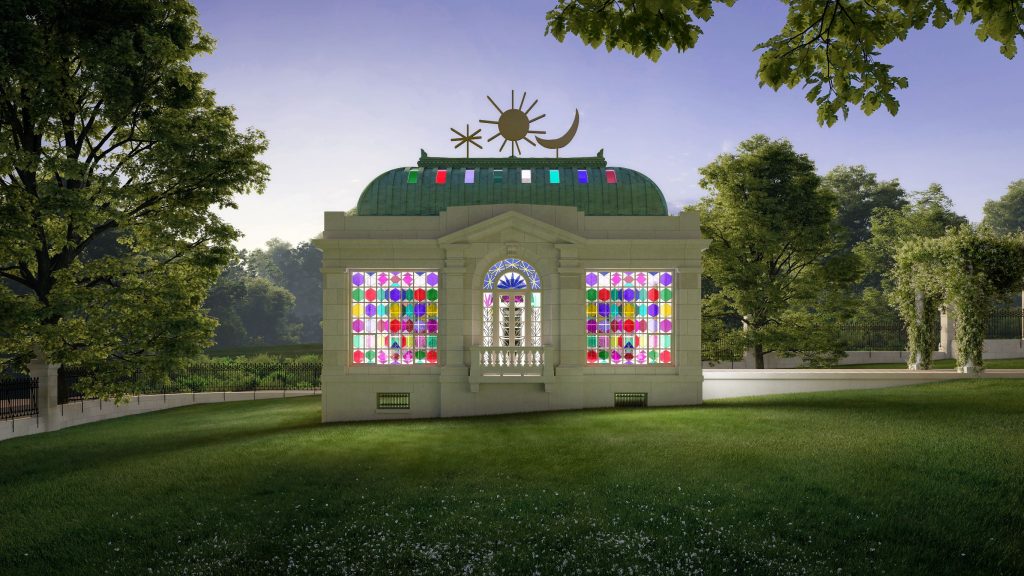
JewelHouse will serve as a space for inclusive history and humanities education, public programs, and events. The curriculum will be developed using restorative practices as a methodology to center the often-untold stories of women across generations. Educational and public programs will include storytelling, spoken word presentations, oral history recordings, collecting initiatives, music concerts, and dance performances, as well as panel discussions, summits, and workshops that nurture civic leadership development and empowerment.
In addition to this regular programming, the Kansas City Museum, in collaboration with Kemper Museum of Contemporary Art, will create opportunities for youth mentorship and leadership experiences that reinforce a shared humanity and aim to create a more inclusive future. JewelHouse will serve as a bridge between two Kansas City cultural institutions that celebrate local stories and create access to meaningful art experiences throughout the city. This institutional programmatic alliance will provide a new pathway for innovative collaboration that mobilizes resources with the community.
Summer Wheat’s exhibition Blood, Sweat, and Tears was organized in 2020 by the Kemper Museum of Contemporary Art. Curated by Erin Dziedzic, Director of Curatorial Affairs, this exhibit inspired JewelHouse. To read Dziedzic’s curatorial statement about JewelHouse, please click here.
Summer Wheat (b. 1977, Oklahoma City, OK) is known for her vibrant paintings, multifaceted sculptures, and immersive installations that weave together the history of materiality, figuration, and abstraction in both fine art and craft milieus. Wheat’s densely populated “scapes” envision worlds where time seems to have collapsed and every person, regardless of social status, occupies a shared, equal space, in which both labor and leisure are paths to healing humanity.
Evoking a jewelry box, visitors will step inside JewelHouse and be encouraged to uncover the inner light of their personal stories and the limitless constellation of memory, perspective, identity, and belonging. Inside JewelHouse, visitors will restore and adorn themselves with individual and collective narratives of beauty, strength, creativity, and resiliency.
JewelHouse will breathe new life into the Kansas City Museum’s Conservatory to engender an enveloping experience of shape, color, pattern, and sound. To construct JewelHouse, the building’s original exterior limestone will be restored, and the interior will be renovated. The original perimeter windows and the roof made of copper and glass will be recreated. Wheat will produce artworks for the exterior and interior including stained-glass windows installed onto the recreated windows panes, 24 stained-glass skylights in colors following the birth stone chart, a large stained glass ceiling panel displaying a pattern of stars in blue and yellow, mosaic flooring, mosaic pebble stone seating, a bronze entrance door, and a bronze moon, sun, and star for the roof.
The center of interior of JewelHouse will be a solid white marble floor with a black, white, and gold marble mosaic stone border wrapping around the perimeter of the room. The white marble will act as a canvas, providing a surface for reflections from the stained glass. Eight square and rectangular windows will display a pattern of a coiled snake, and three arched stained-glass windows will have flowers and stars. When sunlight streams through the windows, a field of flowers and stars will be projected onto the marble floor. Similarly, sunlight will stream through 26 skylights, projecting colorscapes across the marble floor. Visitors will be encouraged to explore and discover endless details in the mosaic design.
Wheat’s designs “endeavor to engage vast and intimate connections between people, nature, and the cosmos” (Erin Dziedzic), drawing on the building’s midcentury history as a planetarium and signature Beaux Arts style while forging a new meaning for the space. JewelHouse will create a new type of conservatory where stories and relationships will be collected, grown, shared, fortified, and protected.
